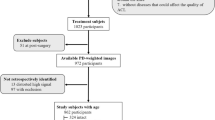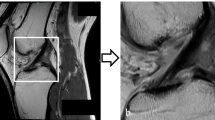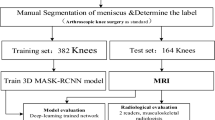Abstract
Deep learning for MRI detection of sports injuries poses unique challenges. To address these difficulties, this study examines the feasibility and incremental benefit of several customized network architectures in evaluation of complete anterior cruciate ligament (ACL) tears. Two hundred sixty patients, ages 18–40, were identified in a retrospective review of knee MRIs obtained from September 2013 to March 2016. Half of the cases demonstrated a complete ACL tear (624 slices), the other half a normal ACL (3520 slices). Two hundred cases were used for training and validation, and the remaining 60 cases as an independent test set. For each exam with an ACL tear, coronal proton density non-fat suppressed sequence was manually annotated to delineate: (1) a bounding-box around the cruciate ligaments; (2) slices containing the tear. Multiple convolutional neural network (CNN) architectures were implemented including variations in input field-of-view and dimensionality. For single-slice CNN architectures, validation accuracy of a dynamic patch-based sampling algorithm (0.765) outperformed both cropped slice (0.720) and full slice (0.680) strategies. Using the dynamic patch-based sampling algorithm as a baseline, a five-slice CNN input (0.915) outperformed both three-slice (0.865) and single-slice (0.765) inputs. The final highest performing five-slice dynamic patch-based sampling algorithm resulted in independent test set AUC, sensitivity, specificity, PPV, and NPV of 0.971, 0.967, 1.00, 0.938, and 1.00. A customized 3D deep learning architecture based on dynamic patch-based sampling demonstrates high performance in detection of complete ACL tears with over 96% test set accuracy. A cropped field-of-view and 3D inputs are critical for high algorithm performance.



Similar content being viewed by others
References
Sanders TL, Maradit Kremers H, Bryan AJ, Larson DR, Dahm DL, Levy BA, Stuart MJ, Krych AJ: Incidence of Anterior Cruciate Ligament Tears and Reconstruction: A 21-Year Population-Based Study. Am J Sports Med 44:1502–1507, 2016
Gianotti SM, Marshall SW, Hume PA, Bunt L: Incidence of anterior cruciate ligament injury and other knee ligament injuries: A national population-based study. J Sci Med Sport 12:622–627, 2009
Perrone GS, Proffen BL, Kiapour AM, Sieker JT, Fleming BC, Murray MM: Bench-to-bedside: Bridge-enhanced anterior cruciate ligament repair. J Orthop Res 35:2606–2612, 2017
Louboutin H, Debarge R, Richou J, Selmi TAS, Donell ST, Neyret P, Dubrana F: Osteoarthritis in patients with anterior cruciate ligament rupture: A review of risk factors. The Knee 16:239–244, 2009
Satku K, Kumar VP, Ngoi SS: Anterior cruciate ligament injuries. To counsel or to operate? J Bone Joint Surg Br 68:458–461, 1986
Fridén T, Zätterström R, Lindstrand A, Moritz U: Disability in anterior cruciate ligament insufficiency: An analysis of 19 untreated patients. Acta Orthop Scand 61:131–135, 1990
Myklebust G, Bahr R: Return to play guidelines after anterior cruciate ligament surgery. Br J Sports Med 39:127–131, 2005
Mink JH, Levy T, Crues, III JV: Tears of the anterior cruciate ligament and menisci of the knee: MR imaging evaluation. Radiology 167:769–774, 1988
Russakovsky O, Deng J, Su H, Krause J, Satheesh S, Ma S, Huang Z, Karpathy A, Khosla A, Bernstein M, Berg AC, Fei-Fei L: ImageNet Large Scale Visual Recognition Challenge. arXiv:1409.0575v3 [cs.CV]:1–43, 2015
Štajduhar I, Mamula M, Miletić D, Ünal G: Semi-automated detection of anterior cruciate ligament injury from MRI. Comput Methods Programs Biomed 140:151–164, 2017
He K, Zhang X, Ren S, Sun J: Deep Residual Learning for Image Recognition. 2016 IEEE Conference on Computer Vision and Pattern Recognition (CVPR). https://doi.org/10.1109/CVPR.2016.90:770-778, 2016
Ronneberger O, Fischer P, Brox T: U-net: Convolutional Networks for Biomedical Image Segmentation. Medical Image Computing and Computer-Assisted Intervention 2015. Springer. https://doi.org/10.1007/978-3-319-24574-4_28:234-241, 2015.
He K, Zhang X, Ren S, Sun J: Delving Deep into Rectifiers: Surpassing Human-Level Performance on ImageNet Classification. Proceedings of the 2015 IEEE International Conference on Computer Vision (ICCV): IEEE Computer Society. arXiv:1502.01852v1 [cs.CV]:1026–1034, 2015
Kingma DP, Ba JL: Adam: A Method for Stochastic Optimization. Published as a conference paper at ICLR 2015. arXiv:1412.6980v9 [cs. LG]:1–15, 2017
Abadi M, Agarwal A, Barham P, Brevdo E, Chen Z, Citro C, Corrado GS, Davis A, Dean J, Devin M, Ghemawat S, Goodfellow I, Harp A, Irving G, Isard M, Jia Y, Jozefowicz R, Kaiser L, Kudlur M, Levenberg J, Mane D, Monga R, Moore S, Murray D, Olah C, Schuster M, Shlens J, Steiner B, Sutskever I, Talwar K, Tucker P, Vanhoucke V, Vasudevan V, Viegas F, Vinyals O, Warden P, Wattenberg M, Wicke M, Yu Y, Zheng X: TensorFlow: Large-Scale Machine Learning on Heterogeneous Distributed Systems. arXiv:1603.04467v2 [cs. DC]:1–19, 2016
Granan L-P, Bahr R, Lie SA, Engebretsen L: Timing of Anterior Cruciate Ligament Reconstructive Surgery and Risk of Cartilage Lesions and Meniscal Tears: A Cohort Study Based on the Norwegian National Knee Ligament Registry. Am J Sports Med 37:955–961, 2009
Kennedy J, Jackson MP, O’Kelly P, Moran R: Timing of reconstruction of the anterior cruciate ligament in athletes and the incidence of secondary pathology within the knee. J Bone Joint Surg Br 92:362–366, 2010
Kruskal JB, Berkowitz S, Geis JR, Kim W, Nagy P, Dreyer K: Big Data and Machine Learning-Strategies for Driving This Bus: A Summary of the 2016 Intersociety Summer Conference. J Am Coll Radiol 14:811–817, 2017
Author information
Authors and Affiliations
Corresponding author
Additional information
Publisher’s Note
Springer Nature remains neutral with regard to jurisdictional claims in published maps and institutional affiliations.
Rights and permissions
About this article
Cite this article
Chang, P.D., Wong, T.T. & Rasiej, M.J. Deep Learning for Detection of Complete Anterior Cruciate Ligament Tear. J Digit Imaging 32, 980–986 (2019). https://doi.org/10.1007/s10278-019-00193-4
Published:
Issue Date:
DOI: https://doi.org/10.1007/s10278-019-00193-4




